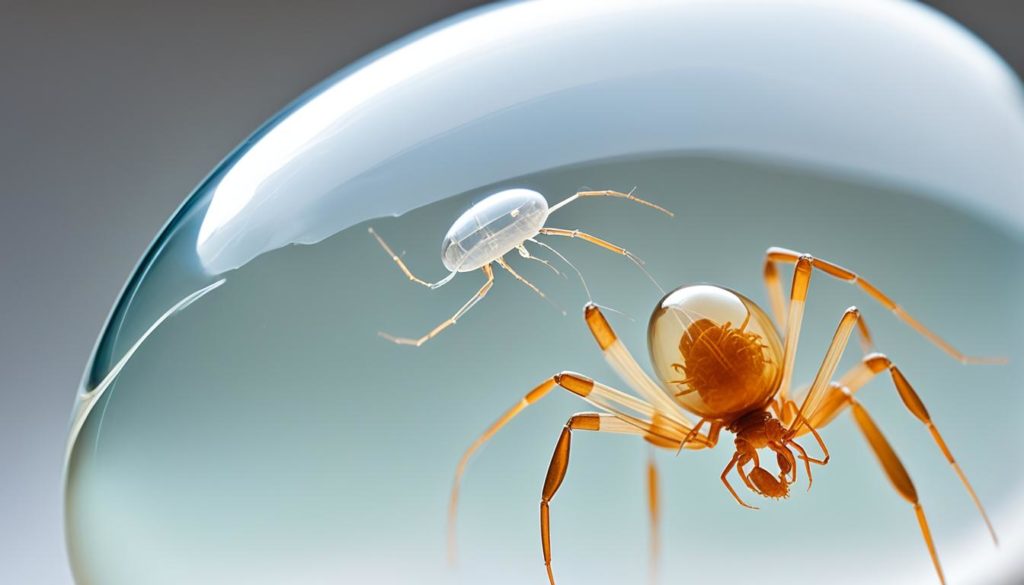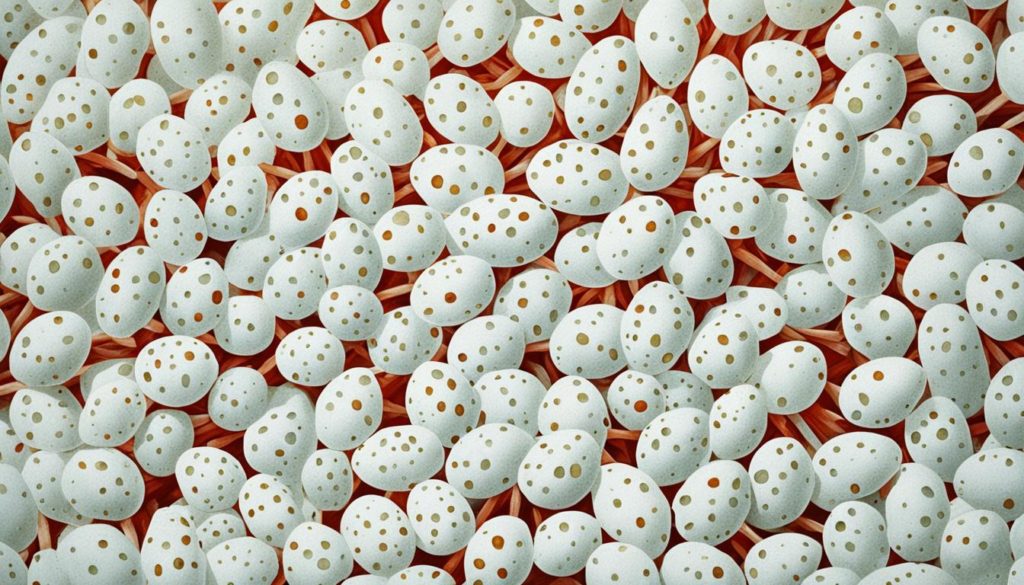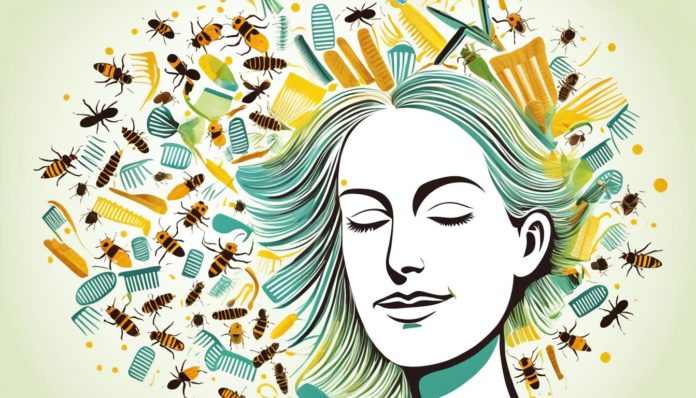Did you know, every year, 6 to 12 million kids in the U.S. get head lice? This shows how crucial it is to have good strategies for preventing and treating lice. Lice problems can be tough, affecting health and causing family stress. Our guide will help you understand how to combat lice and keep your environment lice-free.
We’ll look at different ways to treat lice, share prevention tips, and discuss natural solutions. Knowing about the lifecycle and habits of head lice is key whether you’re currently dealing with them or want to prevent them. Follow along for steps and advice from experts on avoiding lice.
Key Takeaways
- Lice infestations affect millions yearly, underscoring the need for proper prevention and treatment.
- Comprehensive lice prevention strategies include personal hygiene and environmental control.
- Multiple treatment options are available, from topical applications to natural remedies.
- Regular use of a lice comb can help manage and prevent infestations.
- Effective lice management requires a combination of preventive measures and timely treatment.
What Are Lice?
Lice are tiny bugs that live on people’s hair and skin. They cause an annoying condition called pediculosis. It’s easy for kids to get head lice from being close to others. Knowing about lice types and their life cycle helps in treating and preventing them.
Types of Lice
Humans can get three main types of lice:
- Head Lice: These lice make their home on the scalp, often found in children.
- Body Lice: They live on clothes and bedding, but feed on the skin.
- Pubic Lice: Also known as crabs, they live in pubic hair and other coarse hair.
Head lice spread easily in places like schools, making them a big problem.
Lifecycle of Lice
The lifecycle of lice is key in dealing with pediculosis. Lice go through three stages: nit, nymph, and adult.

| Stage | Description | Duration |
|---|---|---|
| Nit | Eggs are laid by the female louse and stick to the hair. | 7-10 days |
| Nymph | These are young lice that grow into adults. | 7-10 days |
| Adult | They are fully grown lice that can lay eggs, keeping the cycle going. | Up to 30 days |
Understanding these stages is important. It helps find the best way to stop the cycle and get rid of head lice.
Signs and Symptoms of Lice Infestation
Finding lice early is key to getting rid of them successfully. There are clear signs and symptoms to watch for. Learning about these can help you spot a lice issue quickly.
Visual Indicators
Seeing lice eggs, or nits, is a major clue. These small, white or yellow eggs stick to hair, close to the scalp. Nits stay put when you try to brush them off, unlike dandruff. Also, seeing live lice moving around is a sure sign. They tend to stay near the neck and ears.

Physical Symptoms
A big symptom of lice is severe itching. This happens because the lice bites cause an allergic reaction. The constant itchiness can lead to red, inflamed skin or even sores from scratching too much. If a child scratches their head a lot or has red bumps, they might have lice. Finding and treating lice early stops them from spreading more.
Methods to Prevent Lice Infestation
Keeping lice away requires effective prevention strategies. It’s important to focus on both personal hygiene and controlling the environment. This helps maintain a lice-free area.
Personal Hygiene Tips
Good personal hygiene is key to avoiding lice. Let’s look at some important tips:
- Regular Head Checks: Check your scalp and hair often for lice signs. Catching them early stops them from spreading.
- Avoid Head-to-Head Contact: Try not to touch heads with others. This is especially important in crowded places like schools.
- Do Not Share Personal Items: Don’t share things like combs, hats, or hair ties to avoid passing lice around.
- Maintain Clean Hair: Although lice can live in clean hair, keeping hair neat and washed is a helpful prevention method.
Environmental Control
Controlling your surroundings is also vital in preventing lice. Here are ways to keep your home lice-free:
- Clean Bedding Regularly: Wash items such as bed linens and stuffed toys in hot water. Lice can’t survive the heat.
- Vacuum Carpets and Furniture: Often vacuum carpets, furniture, and car seats. This removes any lice or eggs.
- Seal Unwashable Items: For items you can’t wash, seal them in plastic bags for two weeks. This kills the lice.
- Maintain Personal Space: Teach kids to keep their things to themselves. This helps prevent lice from spreading.
Effective Lice Treatments
Dealing with lice can be very stressful. Fortunately, there are many effective ways to get rid of them. Knowing the best treatment options, from creams to pills, can simplify the process. It ensures that you can get rid of lice successfully.
Topical Treatments
One popular method to fight lice is using topical treatments. These products contain ingredients like permethrin and pyrethrins. Permethrin is a man-made chemical. It’s similar to pyrethrin, which comes from chrysanthemum flowers. These ingredients kill lice by attacking their nervous systems.
To use these treatments effectively, follow the directions carefully. You usually apply the treatment to dry hair and leave it on for a set time. Then, you rinse it out well. Sometimes, a second treatment is needed to kill all lice and their eggs.
Oral Medications
Sometimes, lice can be very hard to get rid of. When creams and shampoos don’t work, doctors may suggest pills. Ivermectin is a common pill for treating lice. It’s a different approach since it works from inside your body. This can be a good option for people who can’t use creams or shampoos.
Like all medicines, it’s important to take oral treatments as directed. This helps avoid side effects and makes the treatment work better. This method can be very helpful for people with sensitive skin or allergies to cream treatments.
Knowing the difference between cream and pill treatments helps you choose the best way to fight lice. With the right plan, getting rid of lice can be easier. And you can enjoy a lice-free life once more.
Natural Lice Treatment Options
When thinking about natural remedies for lice, it’s important to find options that are safe and work well. We’re going to talk about using essential oils and home remedies to get rid of lice. These methods are preferred by many who wish to steer clear of chemicals and choose more natural solutions.
Essential Oils
Essential oils are often chosen for getting rid of lice naturally. Tea tree oil stands out for its ability to kill lice and their eggs. It’s known for its strong effect against these pests. Besides tea tree oil, neem oil, lavender oil, and eucalyptus oil are also helpful. Here’s how you can use them:
- Mix a few drops of essential oil with a carrier oil and apply to the scalp. Leave it on for at least 30 minutes before washing it off.
- Add essential oils to your shampoo to enhance its lice-fighting properties.
- Combine essential oils with warm water in a spray bottle and use as a preventative spray.
Home Remedies for Lice
In addition to essential oils, you can find effective lice remedies right in your kitchen. These remedies use everyday ingredients because of their simplicity and effectiveness. Below are some well-known home solutions for fighting lice:
| Remedy | Instructions | Benefits |
|---|---|---|
| Vinegar | Mix equal parts of vinegar and water, apply to scalp, leave for 30 minutes, then rinse. | Helps to loosen nits from the hair shafts. |
| Mayonnaise | Apply a thick layer on the scalp and hair, cover with a shower cap, leave overnight, then wash off. | Suffocates and kills lice. |
| Salt | Mix salt and vinegar, apply, leave for one hour, then wash off. | Dehydrates and kills lice. |
Using these natural remedies can be an effective way to treat lice at home. It’s crucial to follow the directions carefully. Doing so ensures safety and success in getting rid of lice.
How to Use a Lice Comb
Understanding how to use a lice comb is key to removing them. It’s very important to get rid of all lice and nits. Here are tips for choosing the right lice comb and the best ways to remove them.
Selecting the Right Lice Comb
The first step is picking the right nit comb. You want a lice comb that has metal teeth close together. This helps catch and remove both lice and nits. Look for these things when shopping:
- Material: Choose metal over plastic, as plastic might not catch every nit.
- Spacing: Teeth need to be close to grab the smallest nits.
- Ease of use: A comfortable handle makes the comb easier to use.
Proper Combing Technique
How you comb is as crucial as the comb you use. To comb effectively, follow these steps:
- Start with wet hair: It’s easier to comb through wet hair.
- Apply conditioner: It untangles hair and traps lice and nits for easy removal.
- Comb in sections: Divide the hair and comb each section from scalp to tip. This makes sure you don’t miss any spots.
- Clean the comb: After each stroke, wipe the comb on a white tissue or cloth. Check for lice and nits. Then, rinse the comb in hot water for the next use.
By using the correct nit comb and following these steps, you can drastically reduce nits and lice. This ensures a lice-free and stress-free environment.
Dealing with Severe Lice Infestations
Having a severe lice problem can be tough, especially with resistant strains. It’s important to know the right steps and when to get help from lice removal pros.
An effective way to tackle a big lice problem is using several methods together. Combining treatments can help beat the infestation. Let’s look at some main tactics:
- Topical Treatments: Over-the-counter products like permethrin and pyrethrin can work. You have to make sure the lice aren’t resistant to them, though.
- Oral Medications: Sometimes, you might need a doctor’s prescription. Drugs like ivermectin and spinosad are better at fighting resistant lice.
- Professional Assistance: In tough cases, it’s a good idea to call in lice removal experts. These professionals have special tools and the right know-how.
Don’t forget about regular combing with a fine-toothed lice comb. This is key to getting rid of lice and their eggs. Doing it often can help a lot.
Let’s compare different ways to handle severe lice issues:
| Method | Effectiveness | Application |
|---|---|---|
| Topical Treatments | Moderate | Topical application; may need repeat treatments |
| Oral Medications | High | Prescribed by a physician; taken orally |
| Professional Lice Removal | Very High | Performed by trained specialists; thorough and efficient |
To really solve a bad lice problem, tackle all infestation areas and stop them from coming back. Using both home treatments and professional help gives the best results.
Tips for Lice Removal from the Home
Getting rid of lice in your home needs careful attention to detail. Start by washing all bedding, clothes, and personal items in hot water. For items you can’t wash, seal them in plastic bags for two weeks to kill all lice.
Vacuuming plays a key role in removing lice from your home. Make sure to vacuum all carpets, furniture, and car seats thoroughly. Don’t forget to clean hair accessories like brushes in hot water for 10 minutes too.
It helps to use sprays made for lice in your home. Just make sure they’re okay to use around your family. These sprays can get rid of lice on things you can’t wash. But remember to use them as the instructions say.
Here’s a detailed table explaining the essential actions and tools for removing lice from your home successfully:
| Item | Action | Notes |
|---|---|---|
| Bedding & Clothing | Wash in hot water | At least 130°F to kill lice |
| Soft Toys | Seal in plastic bags | Leave sealed for two weeks |
| Carpets & Furniture | Vacuum thoroughly | Don’t forget car seats |
| Hair Accessories | Soak in hot water | At least 10 minutes |
| Lice-Specific Sprays | Apply as directed | Safe for household use |
By cleaning your home carefully and consistently, you can beat lice. Following these steps will help keep your family safe and your home lice-free.
Lice in Schools: What Parents Should Know
Lice infestation is common in schools. Knowing the policy and steps for your child is key. Being informed helps control the spread and treat it effectively.
School Policy on Lice
Schools have policies to handle lice outbreaks. They focus on detecting early and involving parents. Schools do screenings and ask parents to check their kids for lice. They also inform parents if lice are found. For more about these policies, visit the California Department of Public Health guidance.
Now, schools try not to exclude kids with lice. This approach lessens stigma and keeps kids in school. It’s all about teaching parents to identify and treat lice. Schools and families need to work together.
Steps to Take if Your Child Has Lice
Act fast if your child has lice. This stops it from spreading. Parents should follow these steps:
- Tell the school to help control the situation while keeping it private.
- Start treating at home with lice products and combing. Follow directions closely.
- Check and treat all family members if needed.
- Wash bedding and clothes in hot water and vacuum your home.
- Talk to the school about your treatment plan and when your child can return.
Working with the school is crucial to control lice. Quick action and good communication help stop big outbreaks.
Conclusion
Knowledge is your best tool in the fight against lice. We’ve covered every part of dealing with lice in this guide. This includes understanding the types, lifecycle, and how to spot an infestation early.
Effective prevention is key. It involves good hygiene and keeping your environment clean. We’ve looked at treatments too. These range from medicines to natural options like essential oils.
The right way to use a lice comb is also important. It helps get rid of lice effectively. For tough cases, we’ve talked about special strategies. Plus, we gave tips on keeping your home lice-free and what schools do about lice.
It’s crucial to stay alert. The advice we gave will help you manage and stop lice from coming back. This guide not just teaches you about lice but also supports taking action. Be informed and act fast to keep your home lice-free.
FAQ
What are head lice?
Head lice are tiny bugs that live on your scalp. They feed on human blood. Kids are the most common hosts, leading to itching and discomfort.
How can I prevent a lice infestation?
Keep yourself clean and don’t share personal items like hats and combs. Check your hair often. Also, wash sheets and clothes in hot water to control their spread.
What are the symptoms of a head lice infestation?
You’ll feel very itchy. You might see red bumps on your head too. Look out for white or yellow nits on hair strands, close to the scalp.
What are the most effective lice treatments?
Use lotions like permethrin or oils like dimethicone. Sometimes, doctors suggest oral medications. Always follow the product or doctor’s directions carefully.
Are there natural remedies for lice removal?
Natural fixes include tea tree or neem oil and rinses with vinegar or mayonnaise. However, they might not work as well as store-bought treatments.
How do I use a lice comb effectively?
Pick a fine-toothed comb. Comb small parts of your hair from top to bottom. Do this under good light to see and get rid of lice and nits. Combing often is key.
What should I do if my child has lice and attends school?
Tell the school nurse and follow the school’s rules on lice. Start treatment right away. Check and treat the whole family to stop the lice from spreading. Clean all personal stuff too.
How can I clean my home to prevent re-infestation of lice?
Wash and dry all textiles on high settings. Vacuum everywhere well. Also, use lice sprays for items you can’t wash.
When should I seek professional lice removal services?
Get help if the infestation is bad, lice don’t go away, or home treatments fail. Experts can give effective treatments and make sure all lice are gone.


